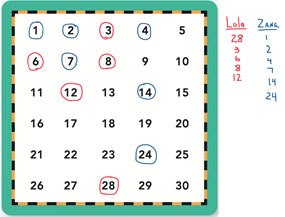Factor Game

How to play
The game involves a paper board with the numbers 1 - 30 listed on a five by six grid. Players take turns choosing a number.
The first player picks a number and the other player selects all the factors of that number that are not circled on the board. Once a number is circled, that number cannot be used again for future turns.
The game ends when there are no numbers with factors left to circle on the board. Each player adds all the numbers that they have circled. The person with the greater total wins the game.
Goal
As the game is played several times, students look for patterns to make better choices for choosing a number. In the process, they are developing and reinforcing their knowledge of multiplication and division as inverse operations, factors, and multiples. Analyzing the game can also reinforce their understanding of basic number theory including prime and composite numbers, abundant and deficient numbers, and perfect numbers.
Game options include extending the game board to contain the whole numbers 1-49 or 1-100. A digital option is also available where a player can compete against the computer or another player.
materials
- Factor Game Board to be used for one game You can print a Labsheet or make one by listing the numbers 1-30 in a five by six grid.
- Pens, pencils, or markers for players to select their numbers on the game board
- The game can also be played electronically with more game board options (Electronic Option One |Electronic Option Two)
Rules
This is a game for two players or two teams.
- Player A chooses a number on the game board and circles or covers it.
- Player B uses a different color and circles or covers all of the other factors of Player A’s number. Recall that the factors of a number are all of the numbers that can be multiplied to get that number. For example, we can find the factors of 12 by thinking about 1 x 12, 2 x 6, and 3 x 4.
- Player B now chooses a new number and Player A circles or covers all of the factors of that number that are not already marked.
- The players take turns choosing numbers and marking factors.
- If a player marks a number that has no factors left that have not been marked, that player loses a turn and does not get the points for the number they originally marked.
- The game ends when there are no numbers remaining with unmarked factors.
- Each player adds the numbers that are colored or covered with his or her color. The player with the greatest total is the winner.
Creative Ideas to Enhance the Game
Analyze the results if you choose different numbers for the first move of the game. What is the best first move? What numbers give you the most points? What numbers give your opponent the most points? What numbers give you the same number of points?
Extend the size of the game board to contain the whole numbers 1-49 or 1-100.
Mathematics Involved
Factors, Multiples, Multiplication, Division, Basic number theory